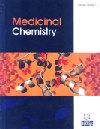Synthesis, Molecular Docking Studies and Biological Evaluation of Thiazolyl Hydrazone Derivatives of Chromone-3-carbaldehyde as Potent Anti-Oxidant and Anti-Inflammatory Agents
IF 1.9
4区 医学
Q3 CHEMISTRY, MEDICINAL
引用次数: 0
Abstract
Introduction: A series of 15 thiazolyl hydrazone derivatives of chromone-3- carbaldehyde have been designed and synthesized by the cyclization of thiosemicarbazone derivatives of chromone-3-carbaldehydes with 4’-substituted-2-bromo acetophenones. Method: All these derivatives were evaluated for antioxidant activity by their direct scavenging activity objects to reactive oxygen species such as DPPH, and nitric oxide, as well as in vitro antiinflammatory activity by a protein denaturation method. Most of these synthesized compounds have shown significant antioxidant activity, among which the compounds 5b, 5c, 5e, 5g, and 5j showed very good antioxidant activities in comparison with the standard ascorbic acid. The in vitro anti-inflammatory activity revealed that the compounds 5b, 5g, and 5h possessed significant activity compared to standard diclofenac sodium. Result: Additionally, molecular docking studies of these molecules using ovalbumin as the protein showed remarkable interactions with its active site residues, and the results indicated that the binding mode of these compounds closely resembled that of the reference compound, diclofenac sodium. Conclusion: Thus, these compounds represent an attractive template for the evaluation of new antiinflammatory and antioxidant agents and might be useful for exploring new therapeutic tools.作为强效抗氧化剂和抗炎剂的色酮-3-甲醛噻唑腙衍生物的合成、分子对接研究和生物学评价
简介:通过铬酮-3-甲醛的硫代氨基脲衍生物与 4'-取代-2-溴苯乙酮的环化反应,设计并合成了一系列 15 种铬酮-3-甲醛的噻唑腙衍生物。方法:通过直接清除活性氧(如 DPPH 和一氧化氮)来评估所有这些衍生物的抗氧化活性,并通过蛋白质变性法评估其体外抗炎活性。这些合成的化合物大多具有显著的抗氧化活性,其中化合物 5b、5c、5e、5g 和 5j 与标准抗坏血酸相比具有很好的抗氧化活性。体外抗炎活性显示,与标准双氯芬酸钠相比,化合物 5b、5g 和 5h 具有显著的活性。结果:此外,以卵清蛋白为蛋白质对这些分子进行的分子对接研究显示,这些化合物与卵清蛋白的活性位点残基有显著的相互作用,结果表明这些化合物的结合模式与参考化合物双氯芬酸钠的结合模式非常相似。结论因此,这些化合物是评估新型抗炎和抗氧化剂的一个极具吸引力的模板,可能有助于探索新的治疗工具。
本文章由计算机程序翻译,如有差异,请以英文原文为准。
求助全文
约1分钟内获得全文
求助全文
来源期刊

Medicinal Chemistry
医学-医药化学
CiteScore
4.30
自引率
4.30%
发文量
109
审稿时长
12 months
期刊介绍:
Aims & Scope
Medicinal Chemistry a peer-reviewed journal, aims to cover all the latest outstanding developments in medicinal chemistry and rational drug design. The journal publishes original research, mini-review articles and guest edited thematic issues covering recent research and developments in the field. Articles are published rapidly by taking full advantage of Internet technology for both the submission and peer review of manuscripts. Medicinal Chemistry is an essential journal for all involved in drug design and discovery.
 求助内容:
求助内容: 应助结果提醒方式:
应助结果提醒方式:


